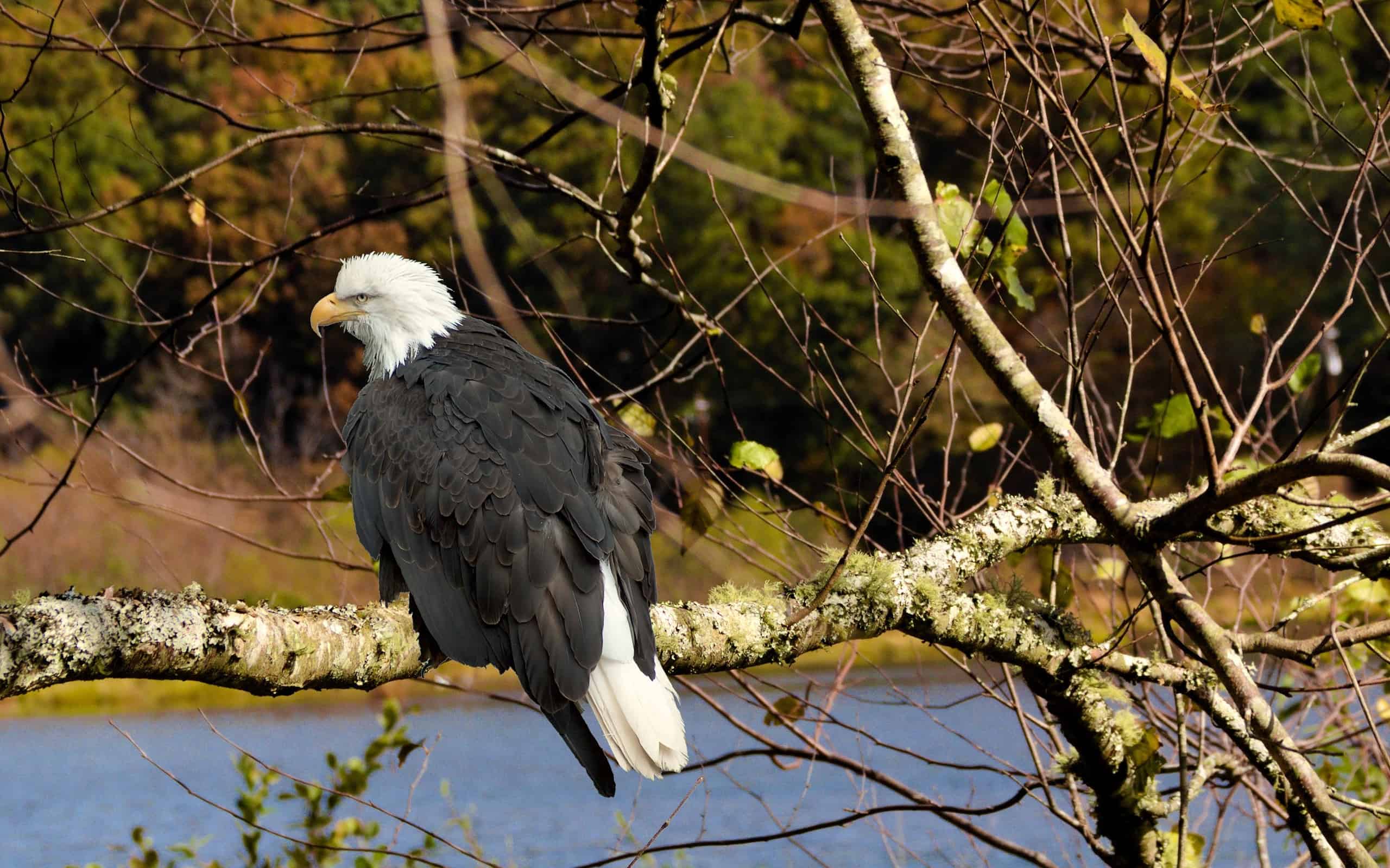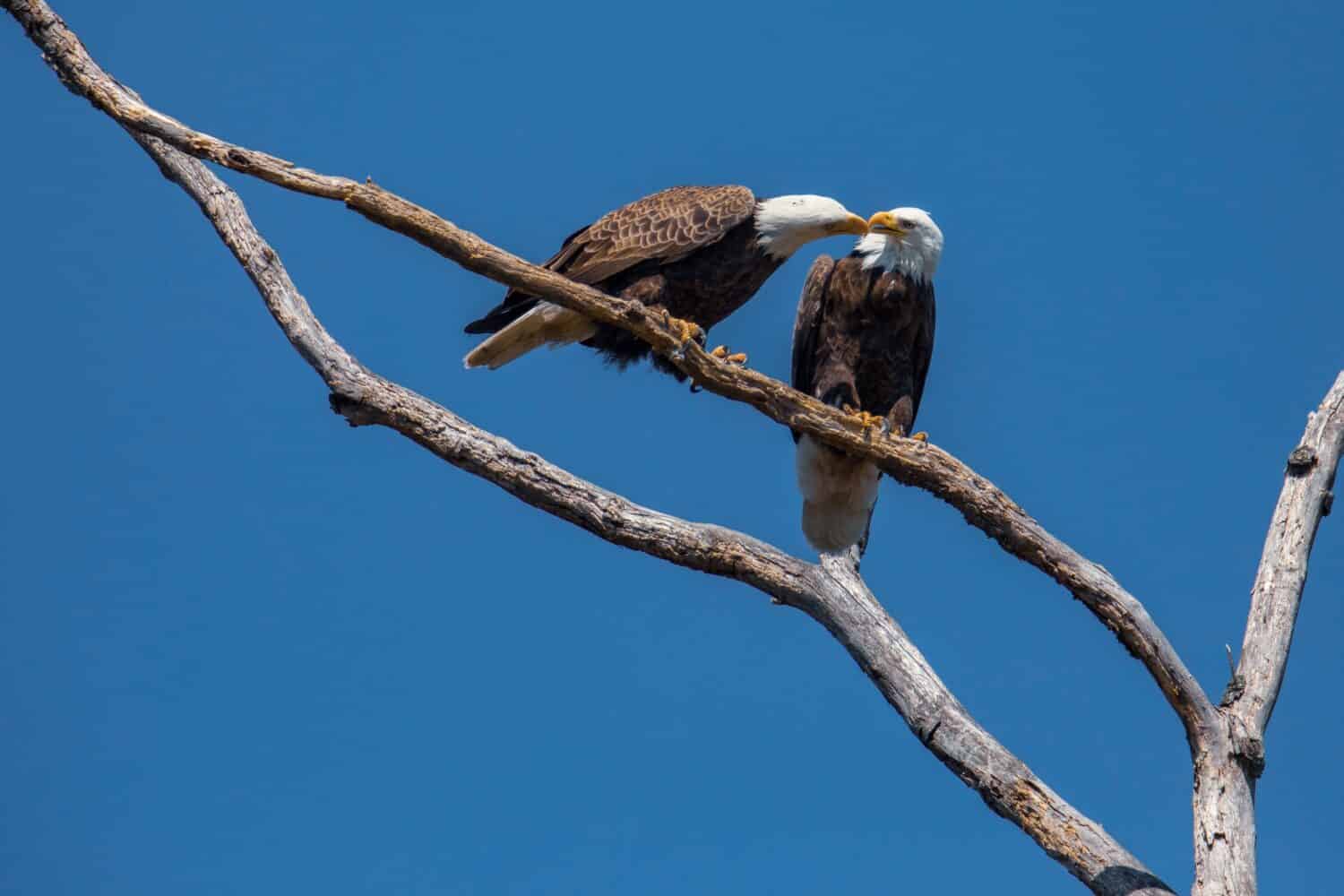Despite being one of the most iconic and easily recognized birds in the world, not much is known about how bald eagles communicate. Although researchers have been able to collect data on the actual sound of bald eagles’ calls, their meanings are often left unknown. However, in the case of a few calls, such as the female’s mating call, scientists have been able to assign a meaning to the unique sounds. Below, learn about 5 common sounds bald eagles make and their meanings.
Adult Chatter

The screech you likely think of belonging to the bald eagle actually comes from the red-tailed hawk.
©Victor Ward/iStock via Getty Images
When you think of the typical bald eagle cry, you likely think of the iconic screech often featured in movies. However, that screech doesn’t actually belong to the bald eagle. Instead, that is the screech of the red-tailed hawk. Despite being a large bird of prey, the bald eagle has a fairly weak screech.
The go-to form of communication for a bald eagle is chatter. Many may compare this sound to a laugh or snicker. This adult bald eagle’s sound includes seven to eight notes chattered in such a way that sound abrupt. Despite being one of the most prevalent forms of adult bald eagle calls, researchers aren’t sure what the meaning of this call is. This sound isn’t seen in juvenile bald eagles, or nestlings.
Female Mating Call

The female’s mating call is thought to be a unique and distinctive sound in nature.
©EleanorAbramson/Shutterstock.com
One of the most unique sounds bald eagles make is the female’s mating call. This sound appears rarely in the species, only when the female is prepared to begin the breeding process. Males have not been exhibited making this sound.
The female bald eagle’s mating call is a soft sound. It is high-pitched, more similar to a screech than a deep, resonating call. Because of this, the sound is often surprising hear, especially given that female bald eagles tend to have lower pitched calls. When a female is looking to mate, she will make this high-pitched sound several times in repetition.
The female’s call is one that is described as wholly unique in nature. As a result, while it may be rare, learning to identify this sound when it is available can help determine whether or not a bald eagle pair is nearby. For many bird-watchers who seek to see one of these majestic birds in a safe manner, this can be a great way to get started. This is especially true given the similarity of many sounds bald eagles make to other species of birds, raptors or not.
Juvenile Cheeping Call

Cheeps or chirps are the main form of communication between young bald eagles and their parents.
©Brian E Kushner/Shutterstock.com
Although some birds may not be born with their eyes open or proper feathers, they are born with the ability to communicate with their parents. Baby bald eagles are born with a light gray down, with their eyes open. However, they still rely fully on their parents for survival. As a result, there are at least two distinct juvenile calls: the cheeping call and the peal call.
The juvenile bald eagle’s cheeping call sounds much like the chirp of any other young hatchling. This call develops prior to the peal call but after the less common peep call. The peep call is a single note that occurs soon after the nestlings first hatch.
Until the juvenile bald eagles develop their peal call, which will later change once more into their final, adult peal, they will rely on their cheeping call for much of their communication with their parents. This call can convey a variety of messages, from asking for food to sounding an alarm when threatened.
Juvenile Peal Call

The young bald eagle’s danger cry will grow into the adult peal.
©wendy blanchard/Shutterstock.com
The juvenile peal call becomes present in nestlings once they reach a few weeks old in age. While the cheeping call is still present, the juvenile’s peal call becomes its primary way of expressing that a specific threat is nearby. Most often, researchers have observed the juvenile’s peal when approaching the nest.
For many that get the opportunity to hear a juvenile bald eagle’s peal call, it will sound much like that of a gull. Like many other bald eagle cries, these are high-pitched. However, rather than the adult’s abrupt chatter, the juvenile’s peal calls are prolonged and drawn-out. Usually, the peal involves six to seven notes.
Adult Peal Call

The adult’s peal call is used to warn of nearby danger.
©iStock.com/Genfirstlight
The adult peal call is most commonly heard in males of the species. Like in juveniles, the peal call is used as a defensive mechanism to alert others to nearby danger. The adult peal is most often heard when a threat is nearby the nest or even shared feeding grounds. While these raptors tend to stick to their pairs and offspring, they will aid in predator detection for other birds.
Summary of Sounds Bald Eagles Make and Their Meanings
| Sound | Purpose |
|---|---|
| Adult Chatter | Unknown |
| Female Mating Call | Readiness to Breed |
| Juvenile Cheeping Call | Food, Danger, Communication with Parents |
| Juvenile Peal Call | Warn of Danger |
| Adult Peal Call | Warn of Danger |
The photo featured at the top of this post is © Dorothy matula/Shutterstock.com
Thank you for reading! Have some feedback for us? Contact the AZ Animals editorial team.






